In the harmonious world of gardening, where plants intertwine and work together like a symphony of green, there exists a magical phenomenon called companion planting. Like kindred spirits, certain plants form synergistic relationships and create an ecosystem that thrives on balance, protection, and mutual growth. And in the realm of cucumber cultivation, these alliances can be the key to unlocking a bountiful harvest and a flourishing garden.
In this article, we will embark on a journey through the labyrinth of companion plants, unveiling the finest allies for cucumbers. These plants possess an inherent understanding of the cucumber’s needs and secrets, allowing them to complement each other’s growth and health in extraordinary ways. We will delve into the realm of organic pest control, exploring the aromatic warriors that shield cucumbers from unwanted intruders. We will also discover the art of nutrient sharing, uncovering plants that enrich the soil and boost the cucumbers’ vitality.
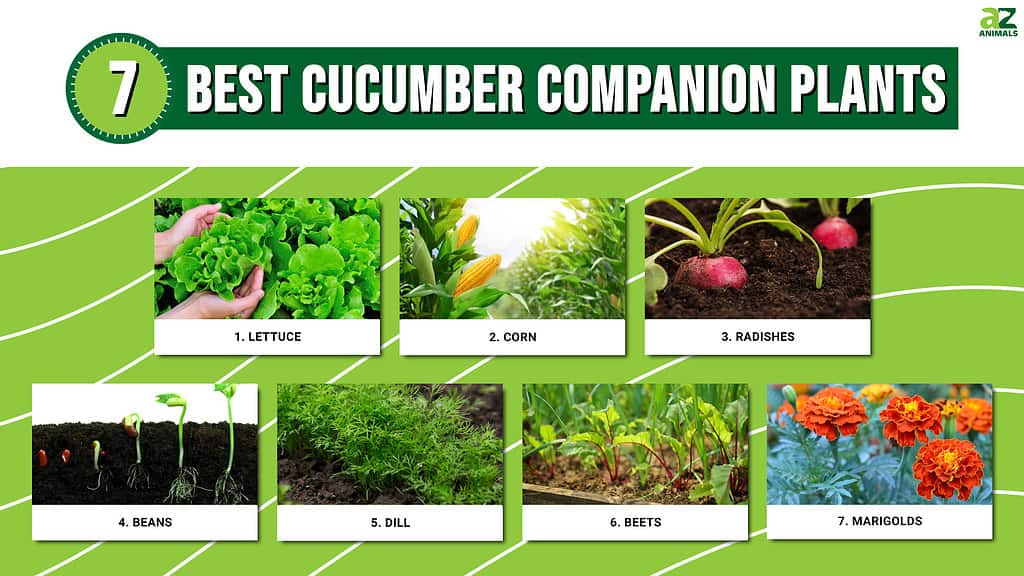
Cucumber Companion Plants to Avoid
1. Melons

Melons like watermelon (pictured) are not considered ideal for cucumber companion planting because they are part of the same plant family.
©Tricky_Shark/Shutterstock.com
When it comes to gardening, some plant combinations are a total hit, and others that you should stay away from. The combination of melons and cucumbers is one such instance. Growing them together might cause issues in your garden.
The fundamental problem comes from the fact that melons and cucumbers are both members of the Cucurbitaceae plant family. This indicates that certain common illnesses and pests can transmit quickly among them. Pests like aphids, cucumber beetles, and squash bugs can move from one plant to the other when these plants are close together, inflicting harm and lowering yields.
Melons and cucumbers should also not be grown together due to their differing development tendencies. Melons are infamous for their expansive nature and their space-consuming tendrils. On the other hand, cucumbers are more petite and like to climb trellises or other supports. When grown together, the melon vines can easily shade out the cucumbers, preventing them from receiving sunlight and limiting their ability to flourish. It’s ideal to offer melons and cucumbers their separate places to maintain the health and production of your garden.
2. Potatoes

To begin with, when it comes to soil moisture, potatoes, and cucumbers have very different requirements.
©Parilov/Shutterstock.com
Although they make a wonderful complement to any garden, potatoes are best avoided when growing cucumbers. To begin with, when it comes to soil moisture, potatoes, and cucumbers have very different requirements. While potatoes need a drier climate, cucumbers love damp soil. The watering requirements of these two plants might conflict when planted together, stressing the plants and possibly leading to issues. Underwatering the soil for cucumbers might cause stunted development while overwatering the soil for potatoes can result in rotting potato tubers.
The possibility of disease is another justification for separating these plants. Both potatoes and cucumbers are prone to blight and other illnesses. The likelihood of disease transmission increases when they are planted near each other because diseases are easily transferred from one plant to another. You may lower the danger of infection and help safeguard the general health of your garden by separating them.
Just as well, how cucumbers and potatoes develop is distinct. Potatoes develop from subterranean tubers, but cucumbers are famous for their spreading vines. When grown together, the cucumber vines may shadow the potato plants, preventing them from receiving enough sunshine to flourish.
3. Fennel
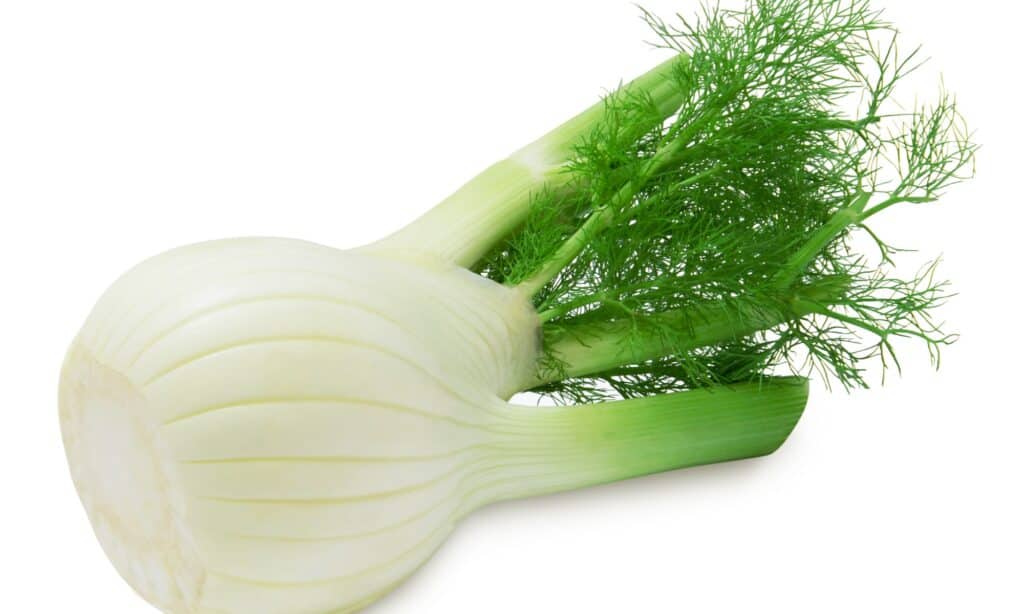
Fennel also has a special characteristic that makes it a difficult plant to grow with cucumbers: it generates compounds called allelochemicals.
©iStock.com/IlonaImagine
Cucumbers and fennel shouldn’t be grown together. The problem of competitiveness is the main reason why. The herb fennel is a tall, bushy plant that likes to bask in the sun. Cucumbers do best when they have plenty of sunshine available to them for fruit formation and growth. Fennel may create shade and overshadow the cucumber plants when they are planted together, reducing their exposure to sunshine and impeding their growth.
Fennel also has a special characteristic that makes it a difficult plant to grow with cucumbers: it generates compounds called allelochemicals. These organic substances may leak into the soil and impede the growth of cucumbers and other surrounding plants. Lower yields may arise as a result of the cucumber plants’ poor development and general health being stunted. Also, fennel has a deep taproot that can compete with cucumbers for soil moisture and minerals.
The Best Cucumber Companion Plants
1. Lettuce
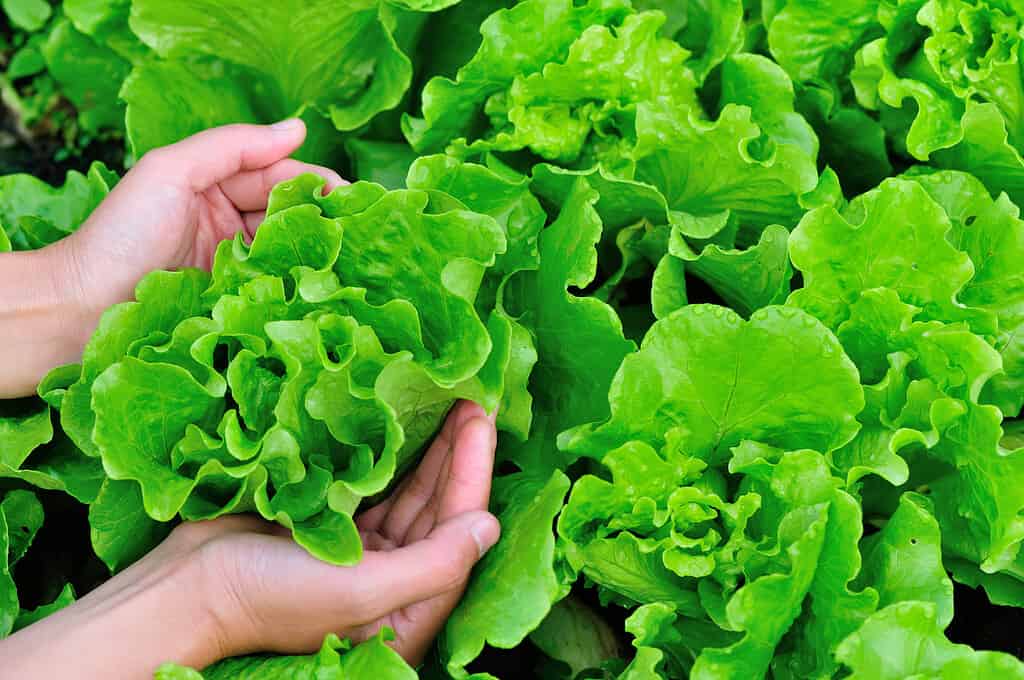
Many types of lettuce (pictured) are excellent cucumber companion plants because they can help cucumbers retain moisture.
©lzf/Shutterstock.com
Lettuce and cucumber get along quite well together. To start, lettuce and cucumbers both need water and sunshine to grow. Although they both want a lot of sunshine, they also value some shade during the warmest times of the day. They can grow next to one another without fighting for light or water, which makes them the ideal pair for planting together.
The cucumber plants also benefit from the shade that lettuce offers. Wide lettuce leaves can serve as a natural canopy to shield the cucumber vines from direct sunlight and keep them from drying out. The soil around the cucumber plants is kept colder and more moisture-retentive by this shade, which is good for their general health and development.
Lettuce may also serve as a live mulch for cucumbers. In addition to weed control, growing lettuce around cucumber plants’ bases helps to preserve soil moisture and keep a more constant soil temperature. Because of this, cucumbers can develop in an ideal environment and concentrate their efforts on making as many tasty fruits as possible.
Lastly, intercropping cucumbers and lettuce can confuse pests and keep them away. Because lettuce has an aroma that many insects dislike, pests may have a harder time detecting the nearby cucumber. This can lessen insect damage and maintain the health of your cucumber plants.
2. Corn

Corn consumes a lot of nitrogen, but cucumbers require a higher concentration of phosphorus and potassium.
©Photoongraphy/Shutterstock.com
The pairing of corn and cucumbers is a match made in gardening heaven. These two plants get along very well with one another. The complementary growth tendencies of corn and cucumbers are one of the main benefits of growing them together. Corn develops into a tall, strong plant that acts as a natural trellis for cucumber vines to climb. This increases the output of your crop and conserves critical ground area by allowing the cucumbers to utilize vertical space.
The corn’s ability to give shade and control moisture is another advantage of this combo. The long corn stalks can provide the cucumber plants with useful shade, shielding them from too much sunlight and minimizing soil water evaporation. This aids in maintaining the soil’s constant moisture content, which is essential for the proper growth of cucumbers.
Just as well, because corn and cucumbers require different amounts of nutrients, they don’t fight for the same ones. Corn consumes a lot of nitrogen, but cucumbers require a higher concentration of phosphorus and potassium. You can guarantee that each plant obtains the precise nutrients it needs by planting them together without depleting the soil of any nutrients.
Last but not least, corn can protect cucumbers from severe gusts that could harm or uproot their fragile vines by serving as a windbreak. The entire stability and health of the cucumber plants are improved by this defense.
3. Radishes
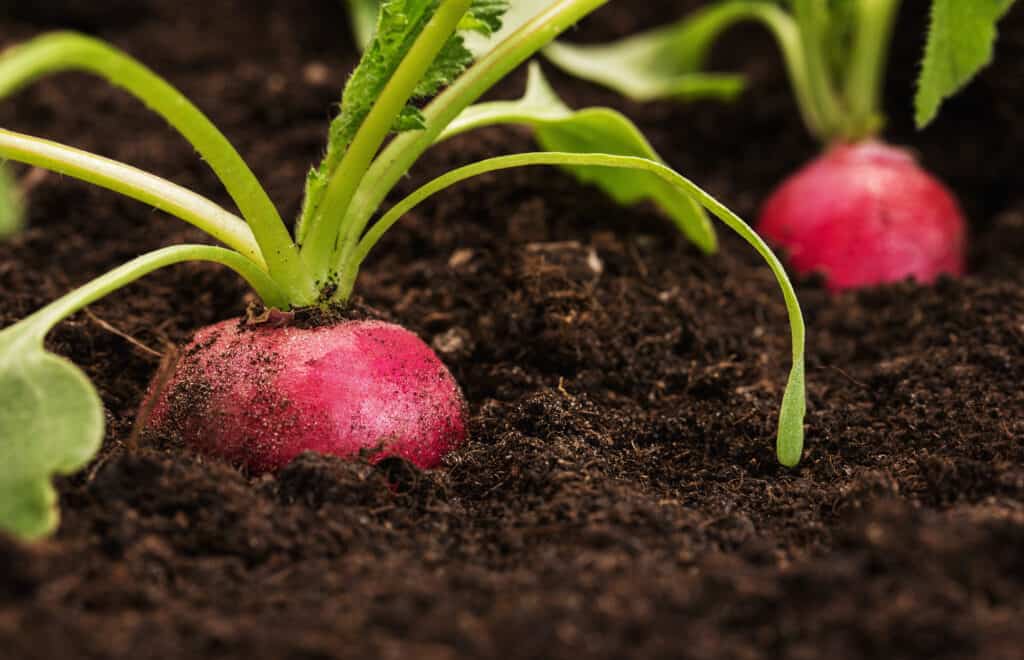
Radishes can act as sacrifice plants and deter pests from attacking cucumbers.
©iStock.com/Nastco
Radishes and cucumbers work well together when it comes to companion planting. The tasty radish is a plant that develops fast and reaches maturity rather quickly. Radishes and cucumbers can be planted together to maximize your garden’s surface area. You can increase the output of your garden by harvesting the radishes quickly rather than waiting for the cucumbers to develop and spread their vines.
Radishes also function as a natural insect repellent for cucumber beetles. Because they eat the leaves of cucumber plants and can spread illness, these bothersome beetles pose a regular hazard to cucumber plants. Radishes have a strong aroma that serves as a natural insect repellent, keeping cucumber beetles away and safeguarding your cucumber plants from their damaging presence. There’s no need for harsh pesticides when you plant these two plants together!
Radishes and cucumbers can also be interplanted because of their similar root systems. The taproot of radishes can help loosen up compacted soil and strengthen it. Encouraging improved water drainage and root growth, which results in healthier and more robust growth, is advantageous to the nearby cucumber plants.
Radishes can also act as sacrifice plants and deter pests from attacking cucumbers. Radishes are a draw for several insects, including flea beetles. You may lessen the damage that these pests do to the cucumber plants, protecting their health and crop, by attracting them to the radishes instead.
4. Beans
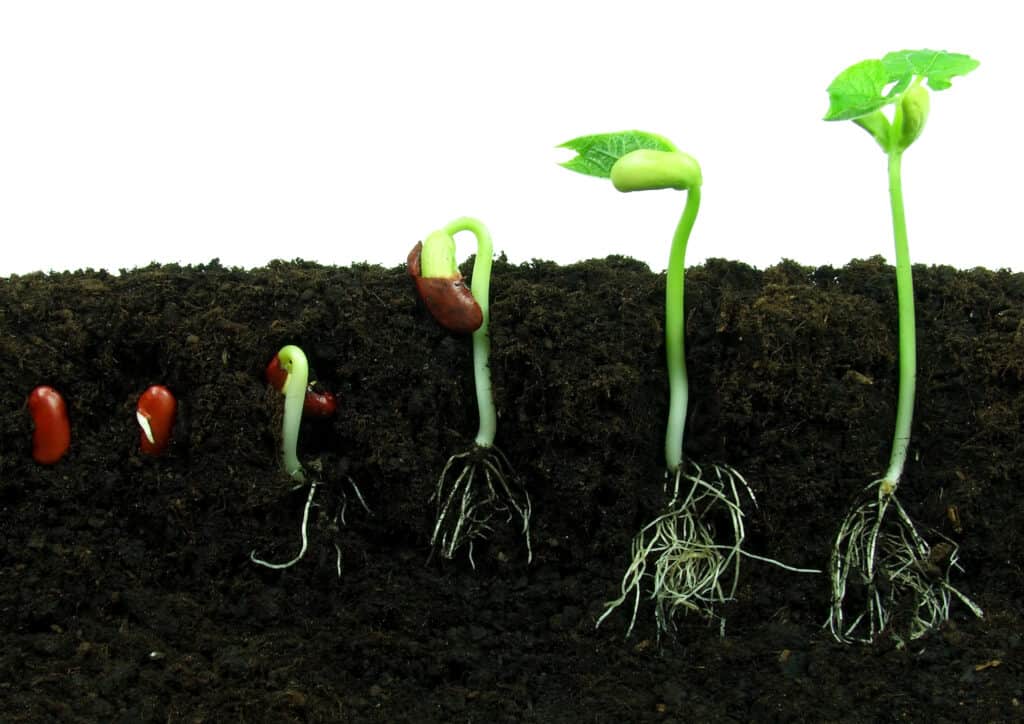
Most types of beans (pictured) can provide shade to cucumber plants and thus help them grow.
©iStock.com/BogWan
The symbiotic relationship between beans and cucumbers in the garden is one of the biggest advantages of planting them together. Beans are nitrogen-fixing plants, which means they can change atmospheric nitrogen into a form that plants can use. That being said, cucumbers require a lot of nitrogen. By cultivating beans close by, they naturally add nitrogen to the soil, boosting the nutrients available to the cucumbers and fostering their healthy growth.
A natural type of shade for the cucumber vines can also be produced by bean plants because of their spreading nature. This cover shields the cucumbers from harsh sun exposure, controls soil temperature, and minimizes moisture loss in the soil. Beans help cucumber plants be more productive and healthy overall by improving their microenvironment.
Just as well, the climbing nature of beans and the vertical growth tendency of cucumbers make them the ideal combination. Cucumber and bean plants can entwine as they climb trellises or other supports, forming a mutually advantageous arrangement. The beans give the cucumbers a strong scaffolding on which to climb, making the most of available space and fostering rapid development.
5. Dill
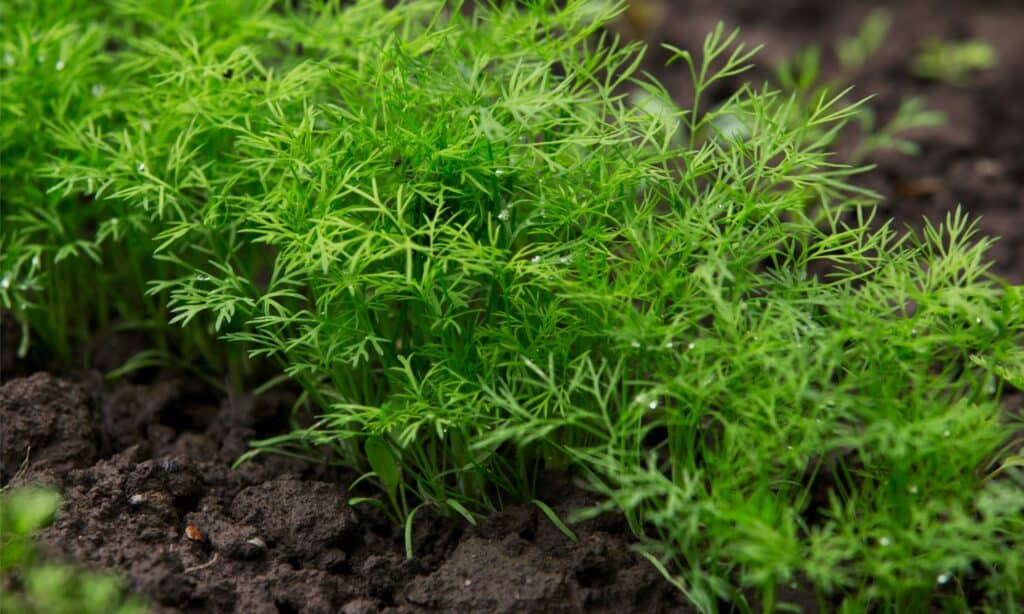
Because of its delicate and feathery foliage, cucumbers can be protected from overexposure to the sun by dill.
©iStock.com/DevidDO
For cucumbers, dill works as a natural insect deterrent. Its fragrant leaves have a unique scent that keeps pests like aphids and spider mites away from cucumber plants. This is welcome, as these pests can cause serious damage. Dill can be grown close by to help form a barrier that keeps off these pesky pests. Doing so can ensure the safety and health of your cucumber plants.
The fact that dill and cucumbers like comparable growth environments are another advantages of growing them together. Both plants benefit from abundant sunshine and well-draining soil, making them good garden friends. You can meet their shared needs by grouping them in a harmonious atmosphere.
Plus, dill can give cucumber plants some shade. Because of its delicate and feathery foliage, cucumbers can be protected from overexposure to the sun by dill. Just as well, this shade keeps the soil surrounding the cucumbers colder and moister, encouraging strong root growth.
Dill also draws helpful insects like ladybugs and lacewings, which eat aphids and other common cucumber pests. You can create a natural pest management system that keeps the cucumber plants safe and growing strong by luring these beneficial insects into your garden.
6. Beets
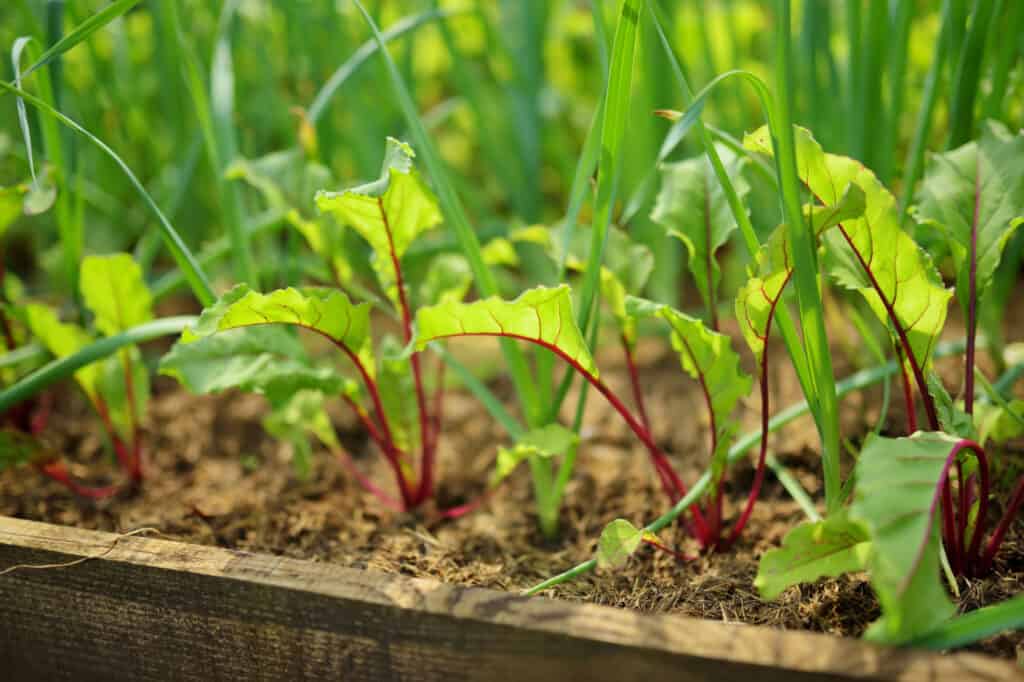
The modest growth rate of beets and the vertical growth habit of cucumbers also make them good partners.
©MNStudio/Shutterstock.com
The fact that beets and cucumbers have different root systems is one of the main benefits of growing them together. Cucumbers have a shallower root system than beets, which have a taproot that penetrates the ground deeply. These two plants can more efficiently exploit various soil depths and avoid nutrient competition when grown together. This maximizes the growth potential of both plants and encourages the formation of stronger roots.
Beets also have a natural weed-suppressing effect. Their thick foliage completely covers the soil’s surface, acting as a living mulch that inhibits the growth of weeds surrounding the cucumber plants. By eliminating the competition from undesirable plants, the cucumbers may flourish while saving you time and effort in weed care.
The modest growth rate of beets and the vertical growth habit of cucumbers also make them good partners. Beets stay closer to the ground, but cucumbers can climb trellises or other supports. By planting them close together, you can maximize the overall plant density while making effective use of both vertical and horizontal space in your garden.
Last but not least, once planted, beets are very low-maintenance plants that need little attention. When planted alongside cucumbers, this can be useful as it enables you to concentrate more on the unique requirements of the cucumbers while still enjoying a secondary crop of delicious beets.
7. Marigolds
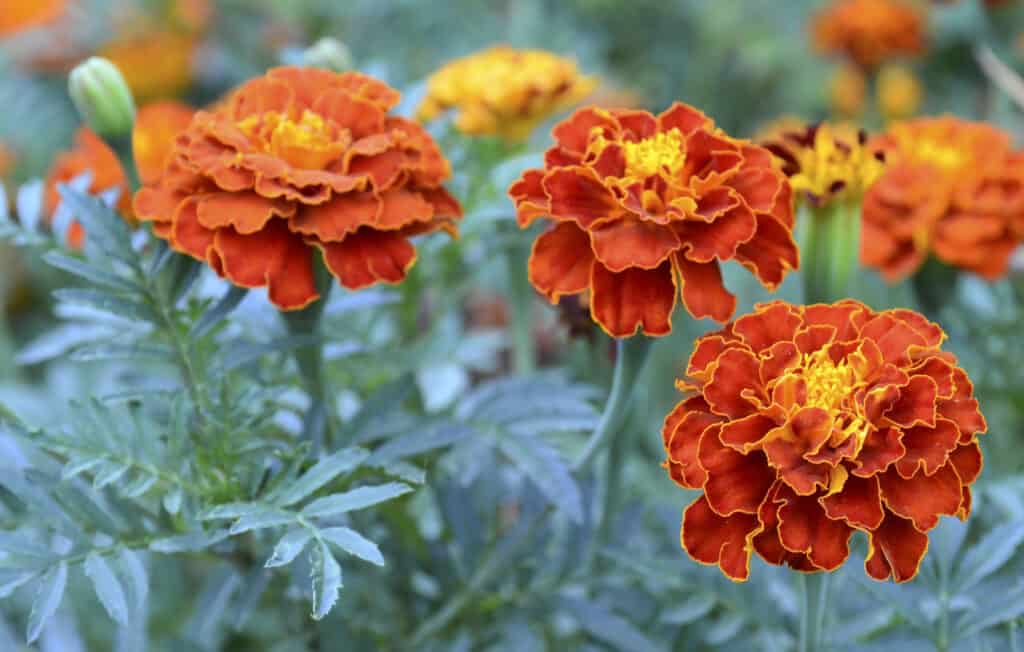
With the help of marigolds, you can create a natural pest management system in your garden that attracts helpful insects and improves the general health of your cucumber plants.
©iStock.com/svf74
Marigolds’ built-in pest-repulsion abilities are among the best reasons to grow them next to cucumbers. Aphids, nematodes, and some types of beetles are among the common pests that are repelled by the strong scent that marigolds exude. Marigolds and cucumbers may be planted together to provide a natural barrier of defense. This barrier lowers the danger of insect infestations and promotes the health and productivity of your cucumber plants.
Marigolds can also attract helpful insects like hoverflies and ladybugs. These beneficial insects consume aphids, mites, and thrips, horticultural pests that can harm cucumber plants. With the help of marigolds, you can create a natural pest management system in your garden that attracts these helpful insects, encourages a healthy environment, and improves the general health of your cucumber plants.
Just as well, marigolds are known for keeping away specific kinds of soil-borne nematodes. Nematodes are tiny worms that can harm plant roots. Because they are prone to worm infestations, cucumbers can benefit a lot from this. By putting marigolds in the same spot as your cucumbers, you can aid in lowering the number of dangerous nematodes in the soil, improving the conditions for cucumber plants to develop and thrive.
There are so many awesome cucumber companion plants out there that would be perfect for your upcoming garden. Just be mindful of the not-so-beneficial plants to avoid planting along with your cucumbers. Happy gardening!
Summary of The 7 Best Cucumber Companion Plants
| Rank | Best Cucumber Companion Plants |
|---|---|
| 1 | Lettuce |
| 2 | Corn |
| 3 | Radishes |
| 4 | Beans |
| 5 | Dill |
| 6 | Beets |
| 7 | Marigolds |
The photo featured at the top of this post is © New Africa/Shutterstock.com
Thank you for reading! Have some feedback for us? Contact the AZ Animals editorial team.






